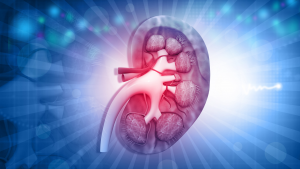Managing Chronic Pain in Hemodialysis Patients
Amanda Nelli, Padma Gulur

Pain can be a complex symptom and is a frequent concern for all patients with a chronic diagnosis, and end stage renal disease (ESRD) is no different. It has been established that 37-50% of patients with ESRD on hemodialysis experience chronic pain, and over 80% of these patients experience moderate to severe pain1. Pain in dialysis patients often goes undertreated, which may be due to the multifactorial cause of pain: physical, social and psychological influences2. There are multiple medical causes of pain in the dialysis population, including complications of diabetes, vascular complications, musculoskeletal disease (eg arthritis) and those directly related to dialysis (accessing vasculature, cramping, etc). Without identifying the cause of the pain, it cannot be adequately addressed. This is a particularly concerning as experiencing this pain can often lead to depression or insomnia, ultimately resulting in withdrawal of dialysis treatments3.
With the complexity of pain in mind, managing pain in patients on dialysis should also have a multifactorial approach; management which includes medication, interventional practices, and therapeutic considerations. Medical management, the use of pharmacologic therapies, may help lower pain level but does not often address the underlying cause of the pain. Because there are so many different pain medications available, it is important to determine the correct medication for they presenting pain symptoms. For instance, diabetic neuropathic pain may be best treated with an anticonvulsant, such as gabapentin, and arthritic pain may be treated with anti-inflammatory agents, like prednisone or ibuprofen. Another crucial factor in managing pain is the side effects of the medications. Some pain medications, such as ibuprofen or naproxen, should be avoided in renal disease as they are metabolized by the kidney, or effect renal function.
Alternatively, interventional practices may be of benefit. This includes local injections, blocks and implant therapies. When appropriate, these modalities can decrease the undesired effected of systemic medications while directly treating the pain. Topical anesthetics may also be of value for local pain symptoms, such as pain caused by accessing the dialysis access. Physical or occupational therapy may also be of benefit. These interventions focus on the origin of pain and can include stretches and exercises to improve physical function for daily tasks.
Cognitive Behavioral Therapy (CBT) is another useful approach to managing pain. CBT is a psychological intervention which combines multiple approaches to best modulate pain and is particularly beneficial in patients with high anxiety or other psychologic comorbidities. These therapies include relaxation, biofeedback techniques, imagery and goal setting. Relaxation has been proven to benefit both pain and anxiety. This can be achieved through breathing techniques, muscle relaxation and passive relaxation. Both biofeedback and imagery play important roles in reaching a relaxed state. Biofeedback uses voluntary control of physical reactions through physiological feedback. Common modalities of use are skin temperature and electromyography. Imagery is a major component of passive relaxation, which may have the most benefit when guided by a therapist rather than self-hypnosis. Goal setting can be either overwhelming or greatly successful. The success of goal setting is found when realistic, and often smaller, goals are set, and can therefore be followed by the patient. As one goal is achieved, more goals can be set. This allows for a stepwise improvement in functionality and pain management. Although patient education by a trained provider must occur for these practices to be successful, these practices should be exercised at home for greatest success and pain reduction. These skills, once attained, allow patients to employ appropriate coping skills for the ongoing emotional and psychological distress of persistent pain.
Summary:
A multimodal approach to managing pain demonstrates great success with complex chronic pain syndromes. Pharmacologic interventions can relieve pain but may not always address the underlying cause of the pain. With this, it is important to consider adjunct therapy with interventional practices and/or CBT. Cognitive behavioral therapy can be a valuable addition of managing pain in dialysis patients as this population often experiences persistent concomitant pain syndromes.
References:
1. Davison SN. The Prevalence and Management of Chronic Pain in End-Stage Renal Disease. Journal of Palliative Medicine. 2007;10(6):1277-87.
2. Davison SN, Jhangri GS. The Impact of Chronic Pain on Depression, Sleep, and the Desire to Withdraw from Dialysis in Hemodialysis Patients. Journal of Pain and Symptom Management. 2005;30(5):465-73.
3. Davison SN, Jhangri GS. Impact of Pain and Symptom Burden on the Health-Related Quality of Life of Hemodialysis Patients. Journal of Pain and Symptom Management. 2010;39(3):477-85

You are apparently very knowledgeable in this area and I have found this to be interesting and intelligent reading. In light of this article, I am aware of Chronic Pain
nice info
Great post! Managing chronic pain in hemodialysis patients can be challenging due to the complexity of their medical condition and potential interactions between pain medications and dialysis treatments. Chronic pain is relatively common in hemodialysis patients and can be caused by various factors, including underlying kidney disease, musculoskeletal issues, neuropathy, and other comorbidities.